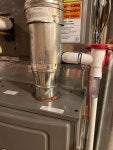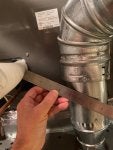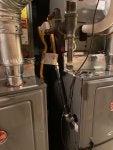Hi all,
Last week we had our twined furnaces and air-conditioners replaced. We haven't had the inspection yet, but there are a few areas I have concerns about. Mainly the spacing between the flue and various pieces of the system. I'd rather get them fixed before the inspection, so I thought I'd ask for some opinions. Our contractor is coming out on Monday to look at some things.
PVC nearly touching the single wall exhaust from the furnace. PVC is combustible isn't it? Shouldn't there be at least 6"?
![]()
Fas valve less than an inch from some type-B vent. I think the the pipe is ok, but wasn't sure about the pipe dope and valve. Is there risk of the getting too hot to turn off?
![]()
Filter drier less than 6" from the single wall water heater vent. It was nearly touching it until I asked them to move it, and this is how far they moved it.
![]()
Insulated AC lineset less than 6" from the single wall vent. Not sure if the insulation is combustible?
![]()
Should there be a sediment trap on the elbow where it enters the furnace?
![]()
Lastly as I'm looking at these photos, I see that there are stickers on the type-b vent. Seems like paper would be combustible, so should those be removed too?
Thanks for looking!
Brett
Last week we had our twined furnaces and air-conditioners replaced. We haven't had the inspection yet, but there are a few areas I have concerns about. Mainly the spacing between the flue and various pieces of the system. I'd rather get them fixed before the inspection, so I thought I'd ask for some opinions. Our contractor is coming out on Monday to look at some things.
PVC nearly touching the single wall exhaust from the furnace. PVC is combustible isn't it? Shouldn't there be at least 6"?

Fas valve less than an inch from some type-B vent. I think the the pipe is ok, but wasn't sure about the pipe dope and valve. Is there risk of the getting too hot to turn off?

Filter drier less than 6" from the single wall water heater vent. It was nearly touching it until I asked them to move it, and this is how far they moved it.

Insulated AC lineset less than 6" from the single wall vent. Not sure if the insulation is combustible?

Should there be a sediment trap on the elbow where it enters the furnace?

Lastly as I'm looking at these photos, I see that there are stickers on the type-b vent. Seems like paper would be combustible, so should those be removed too?
Thanks for looking!
Brett




